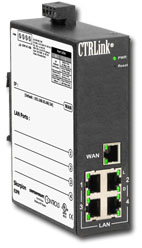Control Network Newsletter

More Features Added to the Skorpion IP Router
 March 2011 - Last November we introduced the EIPR Skorpion IP Router as a simple-to-use industrial grade Ethernet-to-Ethernet router with a built-in four-port Ethernet switch. Its simplicity did not take away from the many advanced features such as a stateful firewall, port forwarding, network address translation (NAT), port address translation (PAT) and dynamic host configuration protocol (DHCP) on both the LAN and WAN sides. Although customers have been happy with the product, we received suggestions on how to make the product better. These ideas have been incorporated in firmware release 1.2.0 which is now shipping with the product.
March 2011 - Last November we introduced the EIPR Skorpion IP Router as a simple-to-use industrial grade Ethernet-to-Ethernet router with a built-in four-port Ethernet switch. Its simplicity did not take away from the many advanced features such as a stateful firewall, port forwarding, network address translation (NAT), port address translation (PAT) and dynamic host configuration protocol (DHCP) on both the LAN and WAN sides. Although customers have been happy with the product, we received suggestions on how to make the product better. These ideas have been incorporated in firmware release 1.2.0 which is now shipping with the product.
Remote Router Access – It is now possible to configure the IP router remotely. The EIPR can be configured via a web browser an attached to one of the four LAN-side Ethernet ports. This is the normal configuration procedure – but with the new firmware, configuration can be accomplished remotely from the WAN side when personnel are not available on-site. Authentication remains the same – a username and password must be entered. However, for extra security the WAN-side administration port defaults to 8080 and is disabled by default. The user has the option of enabling this feature and setting the port number to a different value if desired. We suggest not using well-known ports.
More NAT Entries – Network Address Translation allows for the one-to-one mapping of internal IP addresses to external IP addresses. This is a handy feature when accessing duplicate systems that are configured the same. For example, if we wanted to monitor twenty machines that were manufactured identically with five IP addresses each, we only need to create unique WAN-side addresses for all the devices by configuring the IP router located in each machine. The actual LAN-side addresses can remain the same. With the new firmware, the number of NAT entries increased from five to ten. NAT should not be confused with Port Address Translation which allows several internal IP addresses to share one WAN side address by automatically assigning unique port numbers.
Firewall Disable – With the new firmware it is possible to disable the stateful firewall. With an IP router connected to the Internet, devices on the LAN side can initiate a communications session with devices found on the WAN side. The opposite is not true – WAN side requests are blocked for security reasons. Normally you would not disable a firewall – in fact, the default is firewall enabled. However, the firewall can be disabled when appropriate – such as using the IP router to connect two subnets together within a private intranet. This allows communications sessions to originate from either side of the router. In this situation, NAT and port forwarding are meaningless. It should also be remembered that, although the firewall is disabled, the router will continue to block broadcast messages from passing between the two sides of the router.
Communications Statistics – Another handy feature added with this firmware release is the ability to monitor both LAN-side and WAN-side communications statistics. By simply clicking a button on either the WAN Status or LAN Status pages, the operator can view the number of received and transmitted packets – including any error packets.
In addition to the above features, more HELP screens have been created to assist the user during the configuration process. The EIPR Application Guide has been updated to reflect these changes and can be found on our website.
To learn more, visit the EIPR product page.